Motorcycle racing at Brooklands: ‘Like a wall of death, the track unwinding before you’
Two-wheeled at Brooklands was never as big as car racing, but as Mat Oxley reveals, it attracted some colourful characters who ducked and dived to make a living at the world’s first purpose-built racetrack

Brooklands
Noel Pope watched the vast sweep of concrete banking rush towards him, his mighty supercharged Brough Superior snorting and shaking like an angry bull as he locked his arms against the fuel tank, waiting for the g-force to hit. The banking sucked him in, compressing his body against the bike as he fought against the centrifugal force that wanted to carry him up the banking, towards the edge of disaster, like a roulette ball spinning out of the game.
“Brooklands was in fact nothing more than a vast casino wheel”
It occurred to him at that very moment, when the human mind is working faster than ever but at the same time slows right down, that Brooklands was in fact nothing more than a vast casino wheel. And then, as he started his latest attempt at the Brooklands lap record, he remembered that fortune favours the brave, so he wedged the throttle fully open and said a quick prayer…
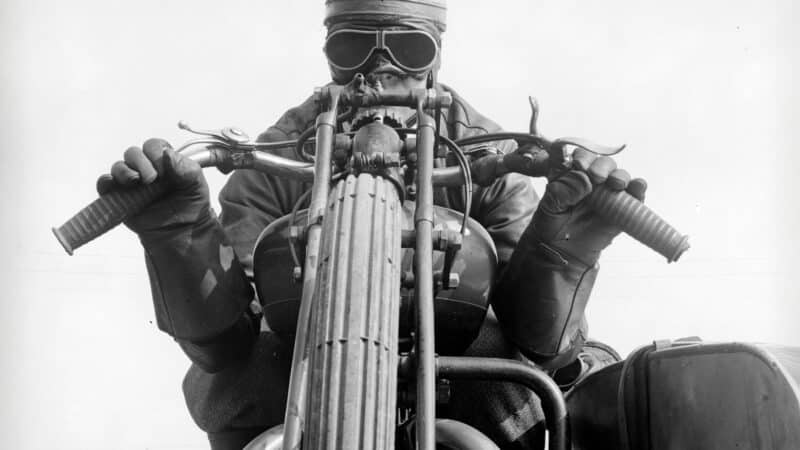
Motorcycle racers were not welcomed with open arms at Brooklands
Getty Images
“At the end of the rolling lap you open up and the acceleration startles you as the Brough leaps suddenly from 90 to 120 and you find it doing its level best to leave you behind,” wrote Pope in his autobiography Full Chat. “But you hang on grimly and use all your weight to bend it around the Fork.
“Onto the Members’ Banking you roar and now the momentum seeks to swing you upwards, and again… over the top. That makes you shift your weight urgently to the other side to keep down. Again and again the footrests scrape – and all the time the back wheel is prodding out.
“Then on you go again, along the banking to the Members’ Bridge, and under it. Here the wind comes up from the Finishing Straight with terrific force, as it often does even on ordinary days. It brings again that threat of forced flight over the top and you fight the wind to win your way down a foot or two.
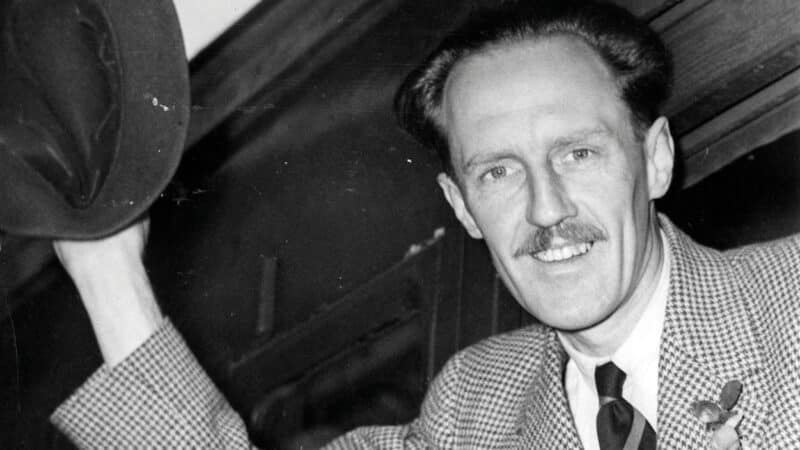
Pope departs London Waterloo in 1949, bound for the US and a crack at the Land Speed Record
Getty Images
“Next the famous bump looms up, growing swiftly; and as you hurtle towards it, you pull the machine straight. It must face head-on dead in line for the Railway Straight or you will land the wrong way round after the leap. So you poise yourself on the footrests and make quite sure you have an even pull on each handlebar. The machine is still heeled over and you have a tendency to continue lugging harder on one side. But you must have that wheel straight for landing.
“The greater your speed, the higher the bump seems to stand up before you, and the swifter it grows. You take the leap. You live through a breathless split-second in mid-air, wondering if you will land square; then thrill with relief and delight as you feel the wheels touch and take ground faultlessly. That’s over, at least!
“But now you press on again, for the Railway Straight, which, for real exhilaration, is to my mind the high spot of the dice. Here, with the machine running somewhere up towards 160mph, the scenery seems to leap at you. It no longer waits passively while you approach it.
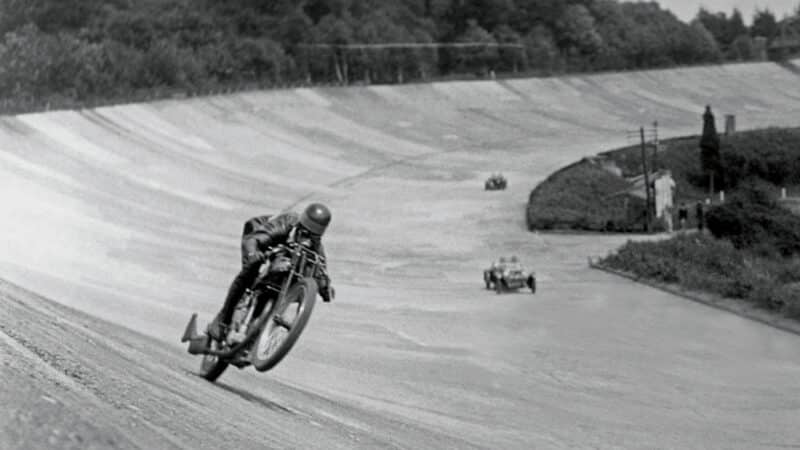
Brooklands 1938, with Pope in typical bat-out-of-hell speed on his 996cc supercharged Brough Superior
Brooklands
“As the machine is in a straight line, and no wrestling match is demanded from you, this part can really be enjoyed, but all too soon it is over and another struggle begins. On the Byfleet Banking, speed has to be briskly reduced, for the machine again wants to disappear over the top. All the way round it is hard work holding it down. If you relax for a split-second the machine sweeps dangerously near the edge.
“The time you will lose over the Fork and that lost on the Members’ Banking has now been made up in the dash down Railway Straight, and now a speed of well over 120mph must be maintained round the Byfleet Banking to keep up the average.
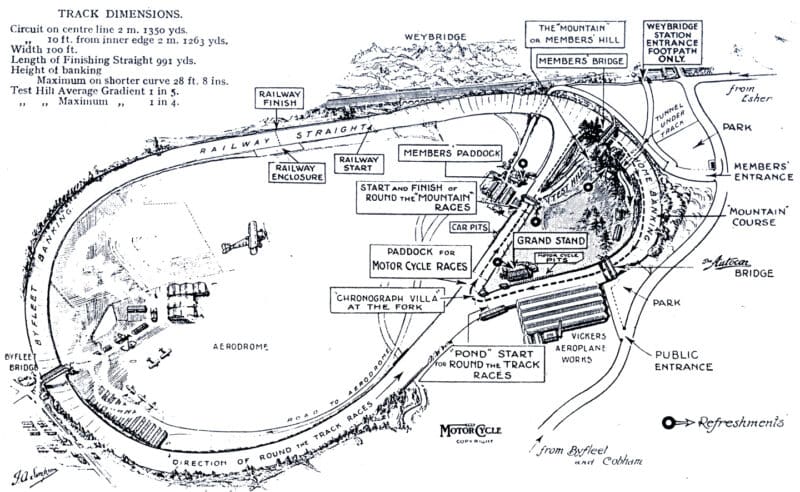
The Motor Cycle magazine’s illustration shows Brooklands as a hub of sporting activity and a lure for companies
Brooklands
“Even at this speed, and although concentrating to keep on the track, the brain still takes in an amazing amount of detail. White faces peering over the fence by the aerodrome, people standing on the Byfleet Bridge – which always makes you duck your head – an aeroplane just landing, a photographer stationed on the top of the track, and all the time, like a wall of death, the track unwinding before you.
“Diving off the banking, then straightening up for the Fork, steering hard over to get round what now appears to be an acute right-hand bend, trying to take the chosen path that misses all the potholes at the Fork, going over to the inside of the track, and shutting off at the same time – this patch really is all-in wrestling, and it is with a breath of relief that one feels the machine slow up the hill. You relax now. You roll into the paddock. Stiffly, you dismount.
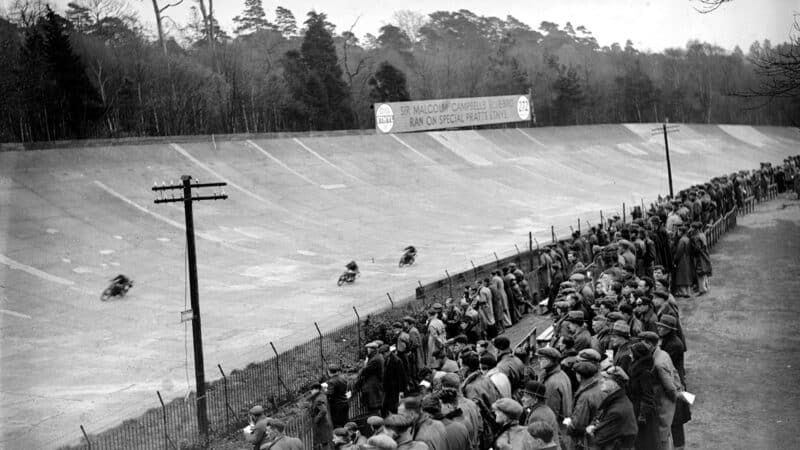
Incredible racing or orchestrated theatre? The crowd, even the media, were none the wiser
Brooklands
“You have only done three miles, but you are quite out of breath, and as hot as the back tyre – which is too hot to touch! The Brough, smelling and making noises like a fried-fish shop, retires behind a haze of smoke. That’s how it was. The Brough had done it for me. The record had been taken at 120.59mph. An ambition was fulfilled!”
That was Pope in the summer of 1935. Four years later, just weeks before the outbreak of World War II, the Liverpudlian raised the record to 124.51mph, 11mph faster than Claude Temple had managed a decade earlier, a feat reported in the first issue of The Brooklands Gazette, published in July 1924. Eleven months after Pope’s 1939 record he was in the Army, being evacuated from Dunkirk.
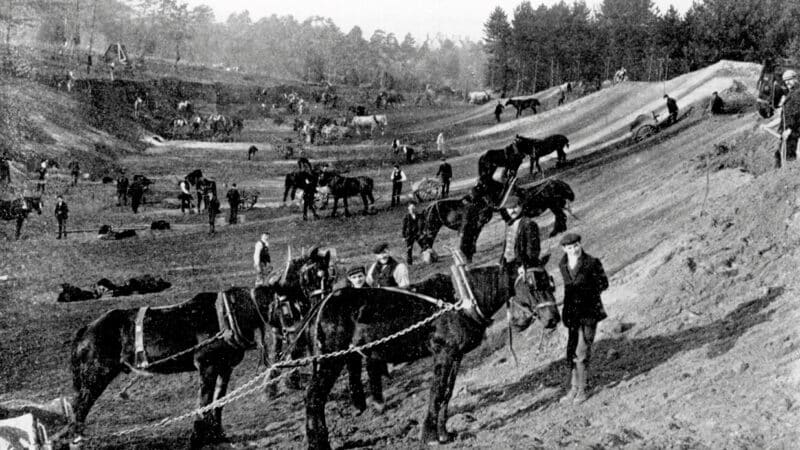
Construction of Brooklands in 1906.
Getty Images
During WWII Brooklands became an important RAF station. Hurricane fighters and Wellington bombers were built within the Vickers and Hawker factories at the track. Barnes Wallis – inventor of the bouncing bomb used in the Dambusters raids – was one of many engineers who worked at the facility.
Brooklands was the first purpose-built racetrack. It opened in 1907, two years before Indianapolis and a decade and half ahead of Monza, with the idea of pushing Britain to the forefront of internal-combustion technology.
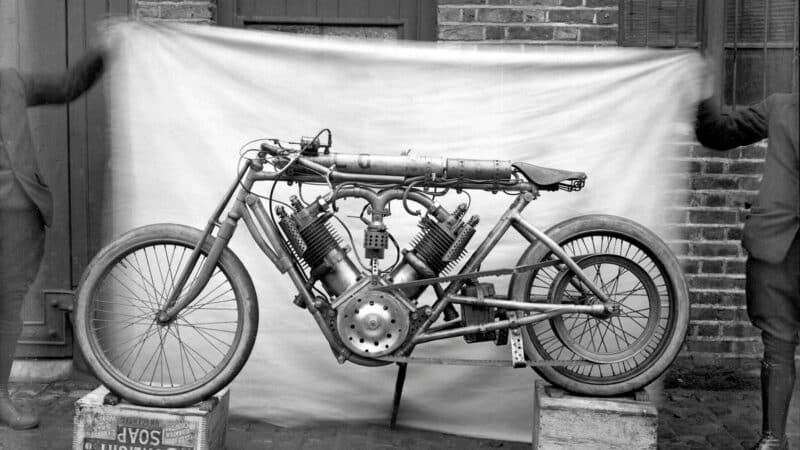
1909 2.7-litre NLG-JAP
Brooklands
The circuit was the creation of wealthy landowner Hugh Fortescue Locke King, who became aware that British machinery was falling behind foreign competition when he watched the 1905 Coppa Florio car race while holidaying in Italy. After the race some foreign enthusiasts told him why British manufacturers were going backwards: they had no chance to run their machines flat out due to the laws banning racing on British roads. So he resolved to do something about it.
“Navvies scoured Brooklands out of 365 acres of Surrey woodland”
Two thousand navvies scoured Brooklands out of 365 acres of Surrey woodland, 20 miles south-west of London. The huge and vaguely oval circuit was 2.7 miles long, 30yd wide and featured two sweeping, banked corners, with banking up to 9yd high, with a 45-degree gradient. Surfaced with a vast expanse of concrete, it looked like an enormous moon crater. And within its centre was an aerodrome that attracted pioneering aviators, the people who gave birth to Britain’s aviation industry, including Tommy Sopwith, creator of the nation’s best First World War fighter plane, and Harry Hawker, whose company built the Hawker Hurricane, the most successful fighter of the Battle of Britain.
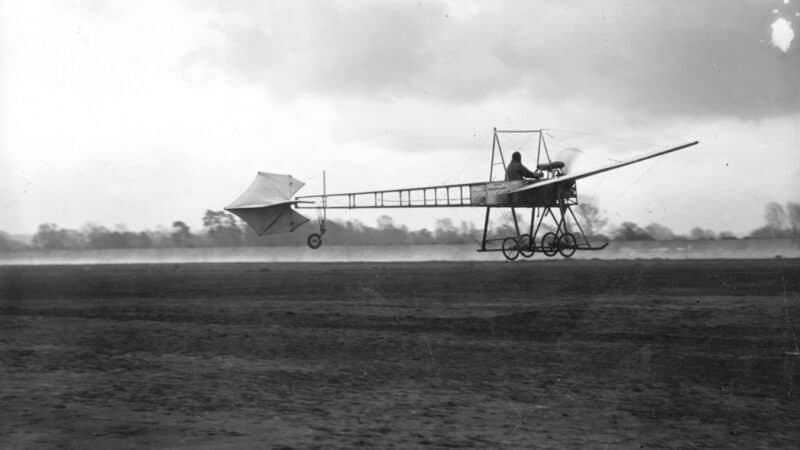
A familiar sight in 1910 to those riders thundering along the banking
Getty Images
Brooklands may have been a wonder of the world, but it wasn’t pretty. “The place was frequently cold and bleak,” recalled a regular. “It could also be hot, dusty, arid and acrid.”
The Brooklands Automobile Racing Club staged its first motorcycle race on Easter Monday 1908, with the riders wearing coloured jockey sashes, because the earliest motor races were run according to horse-racing rules. But the bike racers weren’t treated as equals to car racers. Motorcyclists weren’t allowed in the members’ bar in their riding gear and later they were given their own “rather tatty cafeteria”, separate from the car drivers’ “very swish restaurant”.
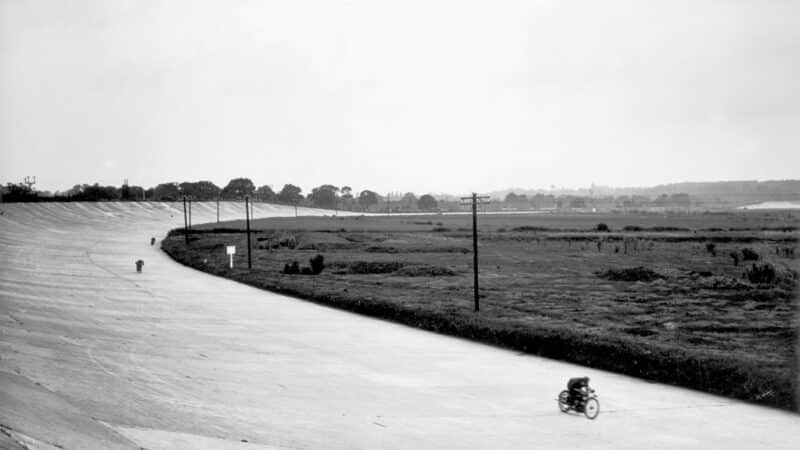
As tracks go, Brooklands was no beauty – bleak in winter and dusty in summer. This is 1910
Getty Images
To be fair, the BARC had some reason for this discrimination: bike racers were a rowdy lot, notorious for all kinds of misbehaviour.
Charles Mortimer, one of Brooklands’ most enduring stars, recalled a motorcycling Christmas party in the paddock dining room, in his book Brooklands: Behind the Scenes.
“The authorities had taken the precaution of removing all the pictures from the walls in the event of riotous behaviour, but this proved to be the last occasion on which a motorcycling dinner was held there, for it developed into a snowballing match with Christmas pudding and custard… which made them decide that motorcyclists were not suitable people from whom to take a booking.”

Oscar Godfrey, 1911 ‘Bemsee’ trials
Getty Images
There is no doubt that Brooklands played a major role in the success of Britain’s car and motorcycle industries, just as Locke King had hoped. The circuit became their testing ground, where machines could be ridden to the limit, accelerating development.
However, many of the earliest motorcycles that chugged around Brooklands had no need for the banking. They were incredibly basic: essentially bicycles with small engines attached; no clutch, no gearbox, no brakes, no suspension, final drive by canvas or rawhide leather belt and engine lubrication by hand pump, a job often required at full speed, while wrestling the bike across the bumps.
The First World War – when Brooklands was home to several Royal Flying Corps squadrons and the newly built Vickers aircraft factory – changed everything. Frantic wartime efforts to increase mechanical efficiency taught engine designers a great deal about valve gear and cooling, lubrication and metallurgy, reduction of weight and size, compression ratios and better fuels.
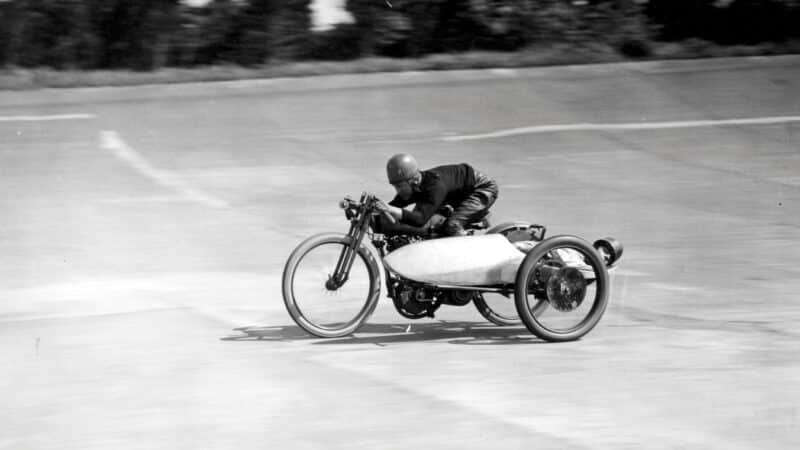
Freddie Dixon on speed-record duty, ’23
All this and much more contributed to Brooklands’ greatest decade, the Roaring Twenties, during which the circuit became the nucleus of British motorcycle development. Norton – the country’s greatest motorcycle racing brand – was based 125 miles away in Birmingham but had its experimental department at Brooklands.
Brooklands didn’t merely change motorcycles, it also changed lives, probably none more so than butcher’s boy Bert Denly, who delivered meat from a shop in nearby Weybridge on a clapped-out, side-valve Douglas twin. One morning in spring 1923 Norton team manager Don ‘Wizard’ O’Donovan climbed into his car to go shopping in Weybridge. Rounding a side turning he came face to face with a wild young thing, slewing his Douglas across the road. A collision seemed inevitable but somehow Denly missed the car by inches. At first O’Donovan was apoplectic; then he got to thinking… who was this kid? Because Norton was looking for a new rider for its Brooklands team.
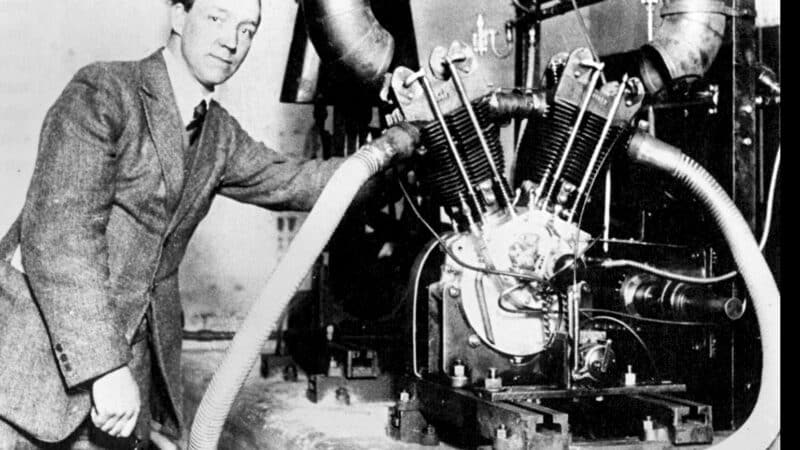
‘Wizard of Brooklands’ Bert Le Vack
Brooklands
As the Douglas flashed past, O’Donovan had noticed a pack of meat strapped to its rear. He put two and two together and tracked down Denly at the local butcher’s to remonstrate with him. Then he offered him the chance of a new job: racing at Brooklands.
Denly had never even been to Brooklands and had no idea who O’Donovan was, so he didn’t bother turning up for his interview. O’Donovan wasn’t to be put off and returned the following Saturday to make Denly a second offer. This time the youngster accepted. He left the butcher’s on Saturday afternoon and on Monday became a factory Norton rider.
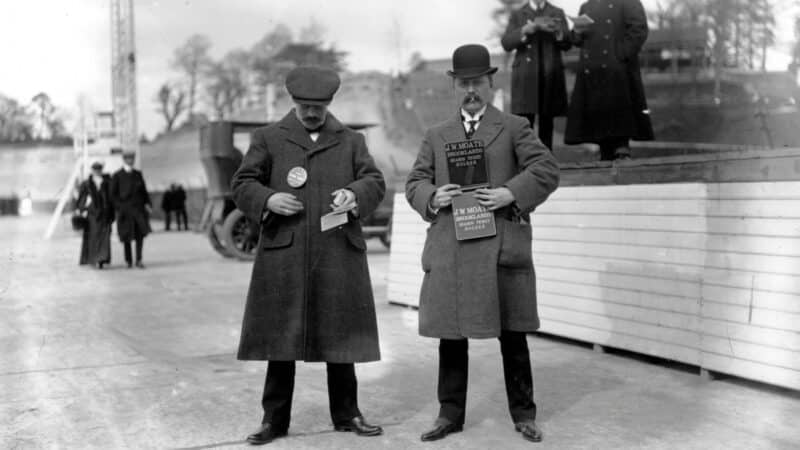
Betting was a major distraction at a Brooklands race day – and some riders could be easily bought to play their part
Getty Images
O’Donovan’s talent-spotting wasn’t mistaken. Within two months Denly had raised the Brooklands 500cc one-hour record to 82mph and won a prestigious 200-mile race at the track. Denly’s only issue was his size. He was tiny, so he fell short of the 9st 6lb minimum weight limit. O’Donovan screwed lead plates into the soles of his boots and sewed more lead into the floral-patterned household cushion that Denly wore strapped to his chest to soften the punishment inflicted by Brooklands’ uneven surface.
“Race-fixing and dodgy betting were a useful addition to earnings”
Riders like Denly could make good money at Brooklands, if they knew what they were doing and were happy to get involved in a little skulduggery. Gambling was big business at the track, thus race-fixing and dodgy betting were routine and a useful addition to earnings.
“It was completely accepted that unless there was a little jiggery-pokery, you could never make your racing pay as it should,” wrote Mortimer, who was a typically racy Brooklands character. His lover at the time was a London stage girl, who danced the can-can. Mortimer’s gang boasted they could drive the 24 miles from London’s Palladium theatre back to Brooklands in a little over 20 minutes, “sometimes on the left side of traffic islands, sometimes on the right”.
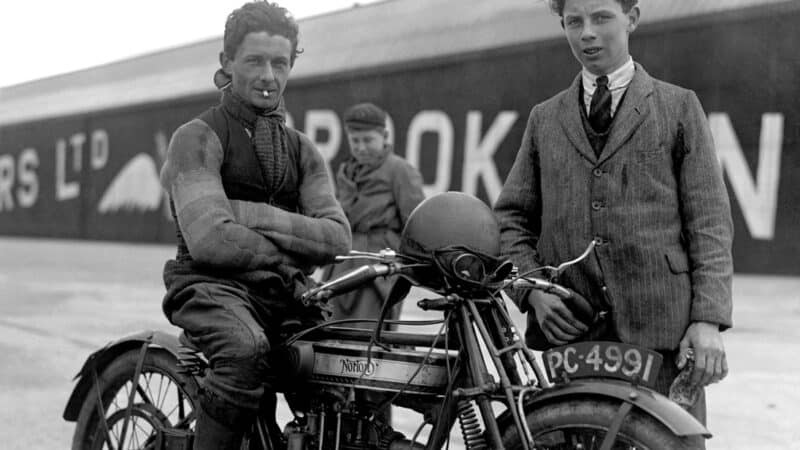
Bert Denly went from nippy Weybridge butcher’s boy to Brooklands record holder
Brooklands
Many Brooklands events weren’t normal scratch races but handicaps, designed to give everyone a chance, regardless of machinery. Slower motorcycles were given a head start, calculated by the timekeepers. The target was to have the best machines from each class crossing the finish line together, to thrill the spectators. Fraud flourished in both scratch and handicap events.
“On occasions, closely contested scratch races were not close at all,” Mortimer recalled. “At one meeting, when closeted in the gentleman’s loo, I was privileged to hear the most enlightening conversation I ever did hear at Brooklands. Unaware of my presence, the loo was visited by three famous riders who, in the belief that they were alone, proceeded to carve up the programme so that the winners of five out of the seven or eight races were decided then and there.
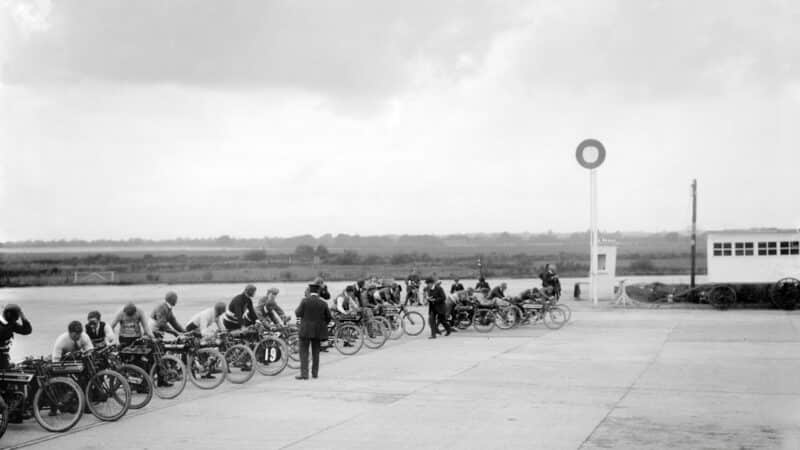
Riders line up at the start of the Short Motorcycle Handicap, part of the BARC Autumn Meeting, 1913
Getty Images
“It was a friendly, even jocular conversation. The plan was adhered to and carried out so superbly that the crowd left the circuit that evening convinced they had witnessed the finest day’s racing they had seen in many a month. Even the motorcycle papers appeared to have fallen for it, for the reporters went into raptures concerning the thrillingly close finishes that day.”
“Racers toiled, trying to make a shilling in this Wild West industry”
Mortimer and his companions operated from sheds within the paddock. The doors were adorned with logos of famous marques and oil and tyre companies. Inside, the racers toiled, trying to make a shilling in this precarious Wild West of a new industry. In many ways Brooklands was a blueprint for 21st century racetracks, wherein the circuit is merely the central focus for a whole range of associated businesses: engineering shops, parts specialists, retail outlets and so on.
“On emerging from the tunnel there was the BARC building, then several petrol stations, first Red Line, then Discol, then Dunlop tyres and the weighbridge,” recalled racer and famed tuner Francis Beart. “There was even electric lighting in some sheds.”
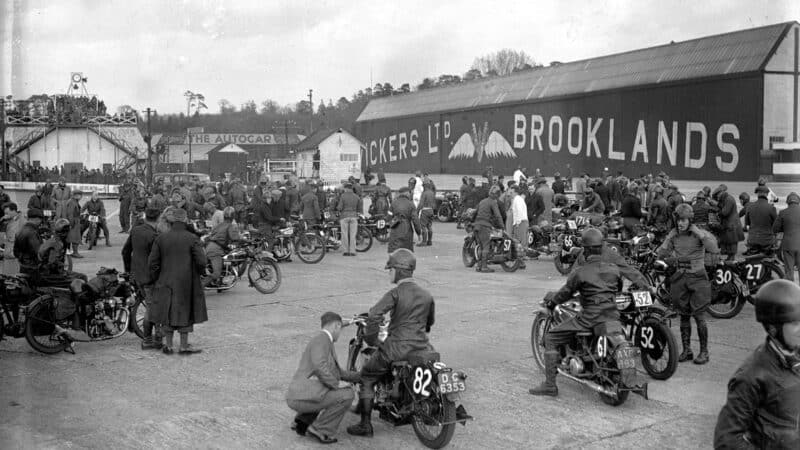
Brooklands was home to plane maker Vickers
Still Time
Interestingly, the same man who did first aid also looked after the toilets.
Inevitably, some of these hard-pressed shed-dwellers sank very low to survive, scamming naive road riders and novice racers.
Mortimer devised a “miniature money-spinner” to con innocent owners of Norton singles. These bikes didn’t run well with the so-called Brooklands can, the compulsory silencers introduced in 1924 following angry complaints from neighbouring residents.
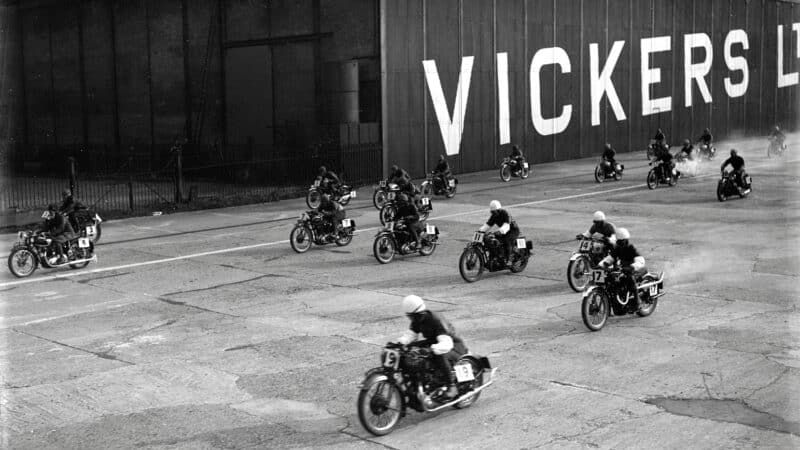
MCC Members’ Meeting, 1938
Getty Images
All he had to do to get the recalcitrant engines running properly was retard the ignition. “Needless to say, we had to indulge in a lot of camouflage, involving the necessity of having the bike on our premises ‘for about a week’ before we could complete the work.”
In fact the fettling only took a couple of hours, after which the bike would improve its lap speed from around 88mph to 98mph. Mortimer charged £1 for every mile an hour, so the little job “earned us £10 for about two hours’ work – a very good hourly rate indeed in 1935”. He wasn’t wrong, a tenner back then was the equivalent of £600 today.
No wonder some local villains saw Brooklands as their own money-spinner. After Mortimer’s shed had been burgled on several occasions he resolved to stand guard overnight, with Beart. They discovered that a gang of lads were boating into the paddock via the River Wey, thereby avoiding the night-watchman on the main gate.
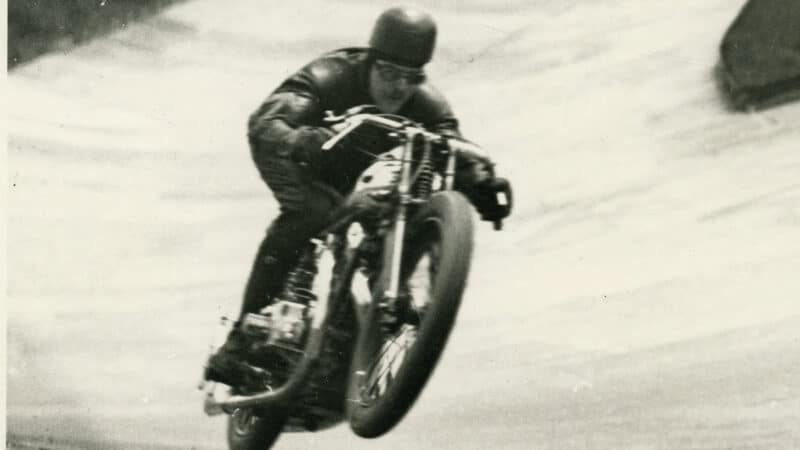
it’s 1937 and Eric Crudgington Fernihough is in a hurry
Brooklands
“We waited a week or two after the latest break-in and then mounted guard again,” wrote Mortimer. “Sure enough, before long we heard the splash of oars and from the depths of the river tunnel emerged the armada, bigger than before and amounting to six or seven boats. When they had nearly reached the paddock, Francis gave the word of command, whereupon my team on one side of the river, and his on the other, emptied two large drums of petrol-paraffin mixture into the Wey, while two large paraffin-soaked handfuls of cotton waste and two matches did the rest.
“The rout was complete and, with the river well ablaze behind them, the invaders’ exit was sealed. But the fire was rather bigger than we expected, and for a time we were so pushed to extinguish the burning gorse lining the banks that we could do nothing about the enemy. But we did get their boats. After that, there was no more trouble.”
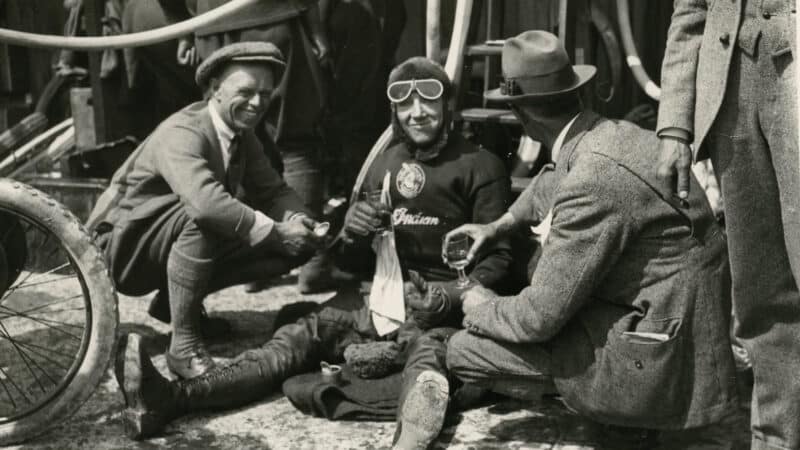
Thirsty work for Le Vack, centre, who won the Brooklands 500 on an Indian motorcycle in 1921
Brooklands
The all-time giant of motorcycling at Brooklands was rider/engineer Bert Le Vack, the London-born son of a Scottish steam locomotive engineer. During the 1920s Le Vack racked up a unique record of Brooklands successes – hundreds of race wins, dozens of records – and he was the first rider to lap the circuit at over 100mph.
Le Vack’s all-round genius included designing engines, tuning them, brewing magic dope fuels and riding these motorcycles beyond their limits. His engine preparation went according to the maxim “infinite capacity for taking pains”, by careful selection of parts, accurate balancing and meticulous attention to the minutest detail.
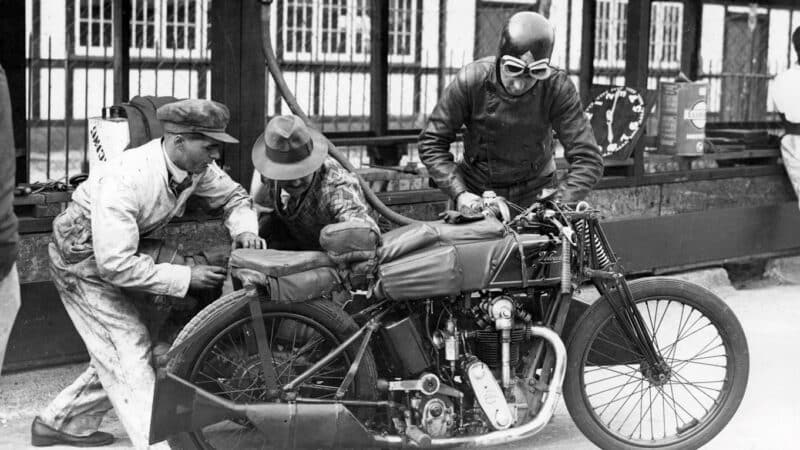
Les Archer was another top name in the ’20s, setting several speed records at Brooklands
Le Vack was probably Britain’s first bike-racing superstar and he believed that what he did at Brooklands wasn’t merely entertainment but benefited the everyday rider.
“Some people question the value of racing,” he said. “The answer is obvious. Some of the things that were last year’s experiments at Brooklands will next year give private owners great satisfaction. The track is a testing ground, be it for racing or touring machines. Even tyres – two years ago a tyre would only last me for one hour at speed; today a tyre has been produced, as a result of racing experience, that is good enough for a full 500 miles at speed. With sparking plugs the same and so with oil, the refiners recognised that speeds were getting higher, so they improved their products. All these improvements benefit the ordinary motorcyclist”.
